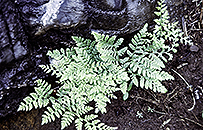Hypodematium crenatum (Forssk.) Kuhn
Synonyms |
Aspidium odoratum Bory ex Willd. |
|---|---|
Common name |
|
Description |
Rhizome shortly creeping, up to 3 cm in diameter; rhizome scales dense, golden brown to rust coloured, concolorous, lanceolate-acuminate in outline, margin entire, c. 1 cm long. Fronds tufted, arching, herbaceous. Stipe up to 20 cm long, straw-coloured, glabrous except for a dense tuft of scales similar to those on the rhizome at the base. Lamina up to 33 x 30 cm, ovate-triangular in outline, up to 4-pinnatifid at the base with the basal pinnae basiscopically developed. Pinnae up to 22 cm long, oblong-acute in outline towards the apex, unequally triangular-ovate at the base. Pinnules thinly hairy on both surfaces, margins lobed to sometimes toothed. Rhachis strawcoloured, with long soft hairs. Sori round, up to 12 per pinnule , 1–1.5 mm in diameter; indusium kidney-shaped, with straight white unicellular hairs. |
Notes | Might be confused with Davallia chaerophylloides. This however has a widely creeping rhizome, pinnae that are weekly basiscopicly developed and glabrous, the sori are situated at the lope tips on the pinnules. Other Dryopteris species are more or less glabrous and have hairless indusia. |
Derivation | crenatum: crenate, referring to the shallow, rounded teeth of the pinnule margins. |
Habitat | Rocky places in bushland; crevices in vertical dolomite rock faces, in soil at the base of rocky outcrops and cliffs, in light shade or sun. |
Distribution worldwide | Africa, Madagascar, Mauritius, southern Asia to Nepal, Japan, Malaysia, Sumatra, Pacific Islands. |
Distribution in Africa |
Angola, Angola, Congo, Dem. Republic of Congo, Ethiopia, Kenya, Mozambique, South Africa, Sudan and South Sudan, Zambia. |
Growth form |
Lithophytic, terrestrial. |
Literature |
|
